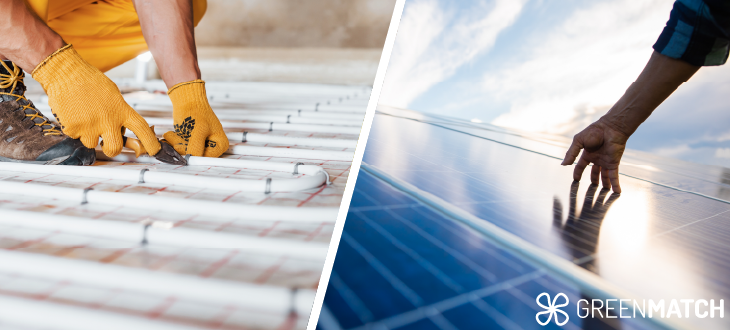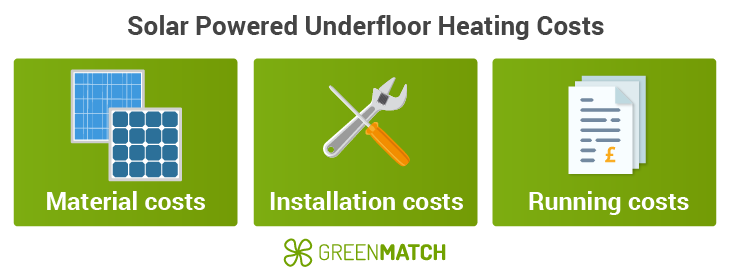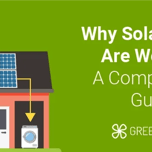Answer these simple questions and we will find you the BEST prices
Which type of solar quotes do you need?
It only takes 30 seconds
100% free with no obligation

Select the energy-efficient solution that fits your needs best

Independent and unbiased, we’ve helped over 12.000 UK homes go green in the last year!

Our service is 100% free and with no obligation
- GreenMatch
- Solar Energy
- Solar Underfloor Heating
Learn All About Solar Powered Underfloor Heating in the UK


Both underfloor heating and solar panels have been increasing in popularity amongst smart homeowners in recent years. In 2019, underfloor heating accounted for 7.7% of heating systems in the UK and is continuing to grow. The demand for solar panels has especially increased in the last year and about 1 million homes in the UK currently have them installed.
This popularity is because of solar powered underfloor heating systems’ high efficiency, low running costs, and available government grants.
If you feel like you’re missing out and want to know how the addition of underfloor heating can benefit your home and pocket, simply click the button below to receive free quotes. You’re under no obligation to accept any of the quotes and can discuss your needs with a professional local installer to find the best fit for your home.
- Quotes from local engineers
- Payment by finance available
- Save up to £1,567 per year
It only takes 30 seconds



What is Solar Underfloor Heating?
A solar underfloor heating system is exactly what the name suggests – using solar panels in the UK to heat your home through heating elements embedded in your floor.
There are two types of solar panels, namely solar thermal panels and solar PV (photovoltaic) panels. Furthermore, there are two types of underfloor heating systems, usually referred to as wet underfloor heating and electric underfloor heating (we’ll explain how each system works in the next section).
This means that no matter whether you have a solar thermal or solar PV system you can use the generated energy to power your underfloor heating system.
How Solar Powered Underfloor Heating Works
Underfloor heating systems use the entire floor area to emit heat to warm up a room. Furthermore, they primarily depend on radiant heat transfer, as opposed to radiators which work by means of convection heat. Radiant heating directly warms up the surfaces of objects (including people), whereas convection heating increases the temperature of the surrounding air.
As mentioned earlier, there are two types of underfloor heating systems: wet and electric.

Solar Powered Wet Underfloor Heating System
Wet systems, also known as water or hydronic underfloor heating systems, involve heating water through a heat source which is then pumped through underfloor heating pipes.
These pipes are also referred to as circuits and are laid within or on top of the subfloor. They are laid down in a shape that ensures the heat is distributed evenly.
The heat source in this case would be solar panels (either thermal or PV alongside a water cylinder), however, other potential heat sources could be a traditional boiler or a heat pump. A manifold and pump mixing unit are installed between the underfloor heating system and the heat source so that the water enters the pipes at a suitable temperature.
It is recommended to use a wet underfloor heating system in conjunction with either a stone or tiled floor, however, carpeted floors are still suitable as long as the underlay is no more than a 1.5 tog (a tog is a unit of measurement to show a material's insulating property).
Wet underfloor heating systems are generally recommended for new builds, as for existing buildings the floor may need to be raised so that the pipes can fit underneath.
Solar Powered Electric Underfloor Heating System
Electric systems, also sometimes referred to as dry underfloor heating systems, can come in the form of either electric heating mats or electric heating cables.
Heating mats use ultra-thin electric heating wires pre-attached to a ready-sized mat which can be attached to the subfloor. Electric heating cables are made up of free-form electric wires which can be installed within or onto the subfloor.
You can generate electricity through solar PV panels and use the grid as a backup source if need be. Then the electric mat or wires convert this electricity into radiant warmth.
This type of heating system is generally recommended for smaller projects in existing buildings, for example, if you only want underfloor heating in your bathroom. This is because electric underfloor heating systems are associated with higher running costs compared to wet systems, however, if you are mainly using free solar energy this will of course be less of an issue.
Furthermore, as with wet underfloor heating systems, it is most suitable to have either a stone or tiled floor. This is because these floor types have a high thermal conductivity, meaning that the heat is able to transfer to the floor surface quickly. These materials also retain heat well, increasing efficiency.
Laminate flooring can also be used with both types of underfloor heating systems, however, it is advised to heat the floor only to a maximum of 27˚C, in order to avoid damaging the laminate.
Both types of underfloor heating systems use a thermostat to control the temperature.
Benefits of Underfloor Heating with Solar Panels
Underfloor heating together with solar panels is the perfect heating solution for modern homeowners in the UK. This type of heating system comes with a range of benefits that are worth taking into consideration when comparing to other heating systems.

As you can see, there are a lot of benefits to combining your solar power with underfloor heating. Something else you can benefit from is comparing quotes from different local installers to make sure you aren’t missing out on the best price.
Comparing quotes is free, quick, and easy, and there is absolutely no obligation to choose any of the quotes you receive. Click the button below to get started.
- Quotes from local engineers
- Payment by finance available
- Save up to £1,567 per year
It only takes 30 seconds



What are the Costs of Solar Powered Underfloor Heating?
When calculating the costs of underfloor heating with solar panels there’s a lot to take into consideration. The initial material and installation costs of setting up an underfloor heating system, especially with the addition of solar panels, can be quite expensive. However, the cheaper running and maintenance costs make it worthwhile.

Material Costs
The material costs will obviously depend on whether you decide to go with a wet or electric underfloor heating system. Electric systems are usually cheaper. For example, for a 60m² home the price tends to start at £2,100 for new builds and £3,600 for renovations.
Wet systems, on the other hand, are quite a bit more expensive, starting at £4,800 for new builds and £9,000 for renovations of 60m². This is because the materials used, such as a manifold, circulation pump and pipes, add up and thus the overall cost is more expensive.
Installation Costs
When it comes to installation costs, wet underfloor heating systems are generally more expensive than electric systems. Again, for a 60m² home, you can expect electric systems to cost roughly £240 - £480 for new builds and £480 - £720 for renovations.
Whereas wet systems cost roughly £960 - £1440 for new builds and £1,200 - £1,680 for renovations of 60m². This is because of the materials used and the amount of time it takes to install a wet system compared to an electric system.
For example, with wet systems more time is needed to test the flow and pressure of the water and to wait for the layer of screed to dry before your floor finish can be fitted.
Therefore, the type of underfloor heating system and the type of property alongside the type of floor cover, the amount of space that needs to be covered, and where you live, can all affect the total installation cost.
This means it’s a good idea to first check with a professional how much underfloor heating will cost for your specific situation. You can click the button below to compare accurate prices of what installers in your area are currently offering, completely free of charge and with no obligation.
- Quotes from local engineers
- Payment by finance available
- Save up to £1,567 per year
It only takes 30 seconds



Running Costs
Typically, this is where you can really benefit from having a wet underfloor heating system. As electricity from the grid is more expensive, with an average price of 28.3p/kWh. However, if you use solar panels this is less of a concern, as you can use free solar energy to heat your home and become less reliant on the grid.
Therefore, with the addition of solar panels both a wet and electronic system can be much cheaper to run compared to traditional central heating. Another advantage of both of these systems is that they can easily be regulated in order to avoid unnecessary heat usage.
Underfloor heating is typically 10–20% more efficient than radiators, as it directly warms the objects in the room from the ground up. Furthermore, underfloor heating requires a lower temperature to produce the same level of warmth in a room, meaning you don’t need as much energy.
The running costs of course will depend on factors such as the size of your home and how much energy you use during the day when your solar panels can generate energy. In order to save even more it’s advisable to use appliances like your washing machine and dishwasher during daylight hours. Alternatively, you could also install a solar battery so that you have unlimited access to solar energy.
If you still need to install solar panels on your home as well, then you should take into account their total cost in addition to this. Thankfully, there are also solar grants available that can help you make up for these upfront costs.
As you can see, underfloor heating is a great option if you want to increase the efficiency of your home and reduce your energy bills. To make sure you’re getting the best deal on the overall price it’s essential to compare quotes from different local installers. This way you can save money on material and installation costs as well as running costs.
Click the button below to get your free quotes and start comparing prices now.
- Quotes from local engineers
- Payment by finance available
- Save up to £1,567 per year
It only takes 30 seconds



FAQ
Yes, solar power can run underfloor heating in your home. Solar thermal panels can directly heat water to power a wet underfloor heating system. While solar PV panels can generate electricity which can be used to power appliances in your home including an underfloor heating system.
Generally speaking, a wet underfloor heating system (also called a water or hydronic system) is the most economical type of heating system when it comes to running costs. This is because it is highly efficient compared to other systems. Furthermore, the average price of electricity in the UK costs 28.3p/kWh, meaning an electric system is more expensive unless you use renewable energy such as solar.
How much electricity an underfloor heating system uses depends on how many square metres it covers and for how long you are using it. For example, if you have an electric underfloor heating system of 125 W/m², for every 8m² you will use approximately 15p per hour it is turned on. Of course, if you generate your electricity from solar panels then the running costs will be cheaper.
Underfloor heating is typically 10–20% more efficient compared to radiators. This is because underfloor heating systems mainly use radiant heat rather than convection heat, and require lower temperatures to get the same results. Therefore, using less energy means that underfloor heating costs less to run.
Stone and tile floors are the best type of floor to use alongside underfloor heating. This is because these materials have high thermal conductivity, meaning that the heat is able to transfer quickly from the pipes or cables to the floor surface. On top of that, these materials also retain heat well, increasing energy efficiency.

Brontë is an experienced writer and editor for GreenMatch. Her passion for sustainability and renewable energy drives her to stay at the forefront of green-energy trends.
We strive to connect our customers with the right product and supplier. Would you like to be part of GreenMatch?

Stay up to date with energy saving tips and grant alerts
Receive offers, marketing and promotions via email from Leads.io about GreenMatch and our brands/partners to help you save.
Thank you for subscribing to our newsletter!
Your email has been successfully added to our list. We look forward to sharing our latest updates with you soon!




